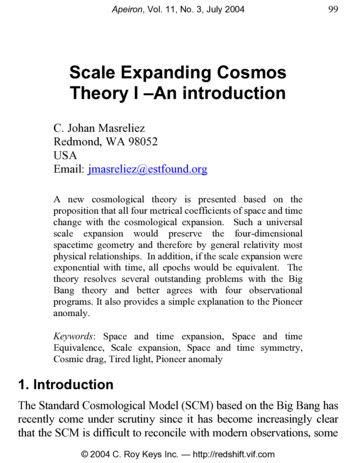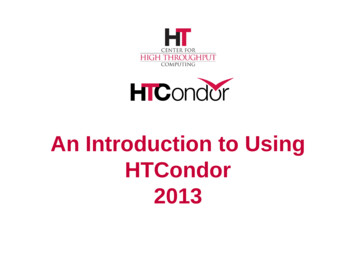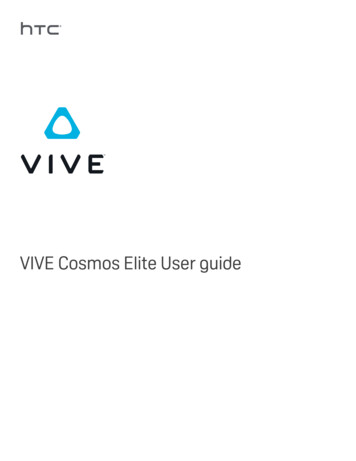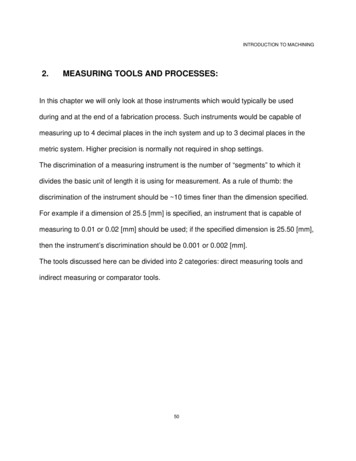
Transcription
Apeiron, Vol. 11, No. 3, July 200499Scale Expanding CosmosTheory I –An introductionC. Johan MasreliezRedmond, WA 98052USAEmail: jmasreliez@estfound.orgA new cosmological theory is presented based on theproposition that all four metrical coefficients of space and timechange with the cosmological expansion. Such a universalscale expansion would preserve the four-dimensionalspacetime geometry and therefore by general relativity mostphysical relationships. In addition, if the scale expansion wereexponential with time, all epochs would be equivalent. Thetheory resolves several outstanding problems with the BigBang theory and better agrees with four observationalprograms. It also provides a simple explanation to the Pioneeranomaly.Keywords: Space and time expansion, Space and timeEquivalence, Scale expansion, Space and time symmetry,Cosmic drag, Tired light, Pioneer anomaly1. IntroductionThe Standard Cosmological Model (SCM) based on the Big Bang hasrecently come under scrutiny since it has become increasingly clearthat the SCM is difficult to reconcile with modern observations, some 2004 C. Roy Keys Inc. — http://redshift.vif.com
Apeiron, Vol. 11, No. 3, July 2004100using the Hubble Space Telescope (HST), see for example Bouwens,Broadhurst and Silk, 1998. The modifications to the SCM demandedby new observational findings are numerous and sometimes mutuallycontradictory, suggesting that the SCM no longer is an accuratecosmological model.In reviewing the developments that led to the SCM, threeimportant milestones may be identified. The first is Einstein’sapplication in 1917 of his General Relativity (GR) theory to thecosmological problem (Einstein, 1917), proposing a static universewith a Critical Density and a Cosmological Constant. This articlepointed the way to future cosmological modeling based on GR, atheory that still is of fundamental importance to cosmology. Thesecond decisive event is the discovery of redshift of cosmologicalorigin that increases with distance by Slipher, 1914, confirmed byHubble, 1929. The third is the papers by Friedmann 1922 and by LeMaître 1927, in which they showed that a spatially expandinguniverse could satisfy the GR equations without a cosmologicalconstant. Although Friedmann considered a GR line element with afixed temporal metrical coefficient and time-varying spatial metric hevery carefully pointed out that this merely is a convenient choice ofcoordinates, since there are innumerable GR-equivalent line elementsrelated by continuous variable transformations. Since the redshiftcould be explained in Friedmann’s spatially expanding universe thistype of line element was eventually favoured leading to the Big Bangmodel with its further refinements that is now the SCM.This article will introduce an alternate path of development, whichleads to a radically different cosmological model.A basic philosophical and physical difficulty with the SCM is thecreation event in which the universe was created instantaneously.This idea is unpalatable because it implies the breakdown of physicsat the time of creation, which would make the origin of the universe 2004 C. Roy Keys Inc. — http://redshift.vif.com
Apeiron, Vol. 11, No. 3, July 2004101forever incomprehensible. Identifying an alternative explanation thatcould address the origin of the universe while staying within thebounds of physical laws would therefore be quite attractive.Exploring the question whether there might be a viable alternativeto the SCM, which does not imply a creation event, various SteadyState theories have been proposed, most notably those by Bondi andGold (1948), and by Hoyle (1948). These theories assumecosmological spatial expansion that opens up voids between galaxies,which are filled by the creation of new matter, for example the C-fieldcosmology proposed by Hoyle and Narlikar (1962). The continuouscreation of new matter and the Cosmic Microwave Background(CMB) are problematic for these theories. Superposed black bodyradiation at different redshifts does not preserve the black bodyspectrum in a spatially expanding universe. Other researchers haveproposed stationary models where the cosmological redshift is causedby spacetime curvature, for example Browne, 1995.As an alternate approach we could consider various variabletransformations of the Friedmann-Robertson-Walker (FRW) lineelement. One particularly interesting possibility is the simultaneousexpansion of all four metrical coefficients rather than just the spatialcoefficients. Such a symmetric expansion would be equivalent toscale expansion. Developing this idea leads to the Scale ExpandingCosmos (SEC) theory presented in this paper.The structure of the article is as follows: The justification andreasoning that lead to the SEC theory is presented in section 2.Section 3 discusses scale invariance, which is central to the theory. Anew phenomenon, cosmic drag, is introduced in section 4. Section 5summarizes several problems with the SCM and how they areresolved by the SEC. Section 6 discusses tired light redshift and thePioneer anomaly is addressed in section 7. Observational evidence forthe theory is presented in section 8 and section 9 is the summary. 2004 C. Roy Keys Inc. — http://redshift.vif.com
Apeiron, Vol. 11, No. 3, July 2004102Throughout this article technical aspects are kept to a minimum. Thereader interested in the technical details is referred to the appendicesand the references.This is a first in a series of articles presenting various aspects ofthe SEC theory.2. Justifying the SEC theoryThe celebrated paradox by Parmenides (born 510 BC) poses thefollowing riddle:Only being is - non-being is not. But, if only being is, there canbe nothing outside this being that articulates it or could bringabout change. Hence being must be conceived as eternal,uniform and unlimited in space and time.Clearly, something that exists cannot have been created fromnothingness; put differently existence rules out non-existence.Accepting this fundamental conclusion, and taking into account thefinding that the universe expands, motivates the search for acosmological expansion mode without cosmological aging thatpermits eternal existence. The fact that the universe is scale invariant,as discussed in section 3, naturally leads to the SEC theory. Sincethere is no absolute cosmological reference scale, the cosmologicalscale of space and time may eternally change with time.The SEC universe evolves by changing all four metricalcoefficients of space and time while retaining the relationshipbetween the four metrics. This is equivalent to scale expansion.Changing all four metrical coefficients in Minkowski spacetime bythe same factor, i.e. the scale of space and time is a well-known gaugesymmetry that preserves equivalence. The GR relations are identicalfor line elements of different scales; all laws of physics modeled byGR are scale invariant. At first we might reject the idea that the scale 2004 C. Roy Keys Inc. — http://redshift.vif.com
Apeiron, Vol. 11, No. 3, July 2004103of the universe might change with time, but then a valid questionwould be: “If the scale of bodies in the universe were fixed, whatcould determine this fixed scale?” Since the GR equations areidentical regardless of scale all physics should remain the same andno physical process or feature of the universe can determine the scale.Therefore there is no predetermined scale – all scales should beequivalent. If this is the case, it is possible that the cosmologicalscale is not fixed but may change with time, which immediatelysuggests that the cosmological expansion could be an expansion ofboth space and time.If this were true, there ought to be no physical difference betweendifferent epochs; by symmetry reasons all epochs should beequivalent. The scale expansion could well be eternal, which wouldeliminate the enigmatic creation event. To preserve temporalsymmetry the expansion must be a geometrical progression wherebythe universe expands by a constant, miniscule, fraction each second.This means that distance and time scales accelerate relative to afictional observer in a universe with fixed scale. In such anexponential scale expansion all locations in space and time would beequivalent.The SEC line element is (with c 1):ds 2 e 2t / T (dt 2 dx 2 dy2 dz 2 )(1)T is the Hubble time.This line element is defined relative to a cosmological rest framegenerated by the scale expansion. This will be discussed in thesecond paper in this series.The redshift-distance relation in the SEC is the same as for tiredlight, which in Appendix 1 is derived from the geodesic for the lineelement (1). It is caused by the scale expansion and is given by theexponential frequency shift of light with time and distance: 2004 C. Roy Keys Inc. — http://redshift.vif.com
Apeiron, Vol. 11, No. 3, July 2004f f0 e t / T f0 e d / cTd cT ln( f 0 / f ) cT ln( z 1)In the SEC there is also time dilation, see further Appendix 1.104(2)(2a)3. Scale invariance in the SEC model.The reader might object that the SEC line element may betransformed into a FRW line element by the transformationt’ Texp(t/T) and that therefore the SEC line element does not offeranything new. However, the SEC line element is physicallyequivalent for translations in space and time.Obviously, the line element remains the same for spatialtranslations, for example x x’ x0 where x0 is a constant positionvector.Temporal translation t t’ t0 gives:ds 2 e 2t0 / T e 2t '/ T (dt 2 dx 2 dy2 dz 2 )(3)Einstein’s GR equations for this transformed line element areidentical to those of the SEC line element; all physical relationshipsremain the same after a discrete scale change. In general, this alsoapplies to all line elements of the form:ds 2 S 2 g µν dx µ dxν ; S Constant(4)Thus, scale expansion of flat or curved spacetimes does not alterphysical relationships; scaled spacetimes are equivalent and scaleinvariance is a fundamental, universal, gauge invariance.The SEC line element models the universe from the perspective ofan observer at t 0 looking back at the earlier universe for which t 0.By scale invariance the same line element applies to all observers inthe SEC universe regardless of epoch. Another way to visualize thisscale expansion mode would be to allow the increment of proper time 2004 C. Roy Keys Inc. — http://redshift.vif.com
Apeiron, Vol. 11, No. 3, July 2004105to change ds ds·exp(t0/T) in (3), which would restore the lineelement (1).Invoking scale invariance takes us “beyond GR” by generalizing itto include discrete scale transformation. This is the main new idea ofthe SEC theory. In the SEC context GR models the four-dimensionalgeometry, but it does not model the progression of time, which ismodeled by the discretely changing scale. This should not come as asurprise; it is widely known that GR is a purely geometrical constructthat will not model the progression of time. GR does not distinguishbetween the past and the present. Also, there is no provision forchanging the pace of proper time in GR, since proper timecorresponds to the global reference increment ds. Yet, it isconceivable that the pace of proper time, as measured out by astationary atomic clock on a geodesic, might change with thecosmological expansion.To be able to apply GR for modeling the SEC universe, the pace ofproper time must be held constant, for example at the present rate,which permits application of the SEC line element and the GRmachinery at this particular epoch. With this approach the universe,as modelled by the SEC line element, appears denser in the past andthe CMB temperature higher. By the pace of present time the age ofthe universe equals the Hubble time. However, this is true for allobservers regardless of their epoch.In a fourth paper of this series I will show that repeated, discrete,scale expansion could model the progression of time and that this alsocould provide the missing link between GR and Quantum Mechanics.The SEC theory implies new physics, and I realize that this mightbe a deterrent. However, this first paper will show that the SEC lineelement accurately models the universe as observed. 2004 C. Roy Keys Inc. — http://redshift.vif.com
Apeiron, Vol. 11, No. 3, July 20041064. Cosmic drag – a new phenomenon.In the SEC relative velocities of freely moving objects diminishexponentially, with a time constant that equals the Hubble time.Also, angular momenta of rotating systems dissipate similarly.This new phenomenon, which follows directly from the GRgeodesic for the SEC line element, is derived in Appendix 1.Cosmic drag explains the motion of matter in spiral galaxies andpredicts that the planets slowly spiral toward the Sun withaccelerating angular velocities. Optical observations in the solarsystem since the intoduction of atomic time have now detected thisacceleration, which will be discussed in my second paper.5. Problems with the SCM in view of the SECMost of the following problems with the SCM may be found in thesummary by Van Flandern, (2002):1. The Big Bang creation.The SEC universe might be eternal. Eternal existence does notviolate the laws of physics. It might seem like the universe eventuallywould run out of energy, but this is not the case if the pace of (proper)time slows down with the expansion. Energy is a relative concept andthe progression of time is intimately related to energy. In the SECenergy lost by the spatial expansion is recovered by a slowing pace oftime.2. The horizon problem.All regions communicate and have always communicated in theSEC. Infinite distance corresponds to infinite redshift. Signals areattenuated by tired light redshift and gradually disappear withincreasing distances.3. The “Omega problem”. 2004 C. Roy Keys Inc. — http://redshift.vif.com
Apeiron, Vol. 11, No. 3, July 2004107If the SCM universe we see today were to be extrapolated backclose to the Big Bang creation, the initial ratio of the actual density ofmatter in the universe to the Critical Density must have differed fromunity by a very, very, tiny amount. Any larger deviation would haveresulted in a universe that either should have already collapsed ordissipated by expansion. This seems like too much of a coincidence.However, in the SEC universe the scale may expand forever withoutchanging the relationship between the four spacetime metrics or thegeometry. Scale expansion preserves all physics including all relativedistances. The cosmological mass density always remains the same.4. The age problem.In an eternal universe objects like stars, galaxies, clusters,filaments, walls etc. may be much older than the Hubble time.5. The universe has too much large-scale structure.The SEC universe could be limitless in time and space permittingthe existence of formations at all scales6. Invisible dark energy of unknown but non-baryonic naturedominates the universe.In the SEC universe the energy-momentum tensor for vacuumdoes not disappear. Informally it might be viewed as consisting of twodifferent parts. A Cosmological Constant with a temporal massdensity component T00 equal to the Critical Density and a positivecosmological pressure. The Cosmological Constant corresponds tonegative energy density due to the spatial expansion, which is exactlybalanced by positive energy density due to the temporal expansion.Although the net gravitating energy disappears in the SEC universe,spacetime contains vacuum energy, see further Appendix 2.7. Very distant galaxies in the Hubble Deep Field show insufficientevidence of evolution, with some of them having higher redshifts(z 6-7) than the highest redshift quasars. 2004 C. Roy Keys Inc. — http://redshift.vif.com
Apeiron, Vol. 11, No. 3, July 2004108All epochs are equivalent in the SEC universe. There is nocosmological evolution; on the average high redshift galaxies aresimilar to nearby galaxies.8. The end of the universe.The much-discussed end of the universe is in the SCM almost asenigmatic as the creation event. The SEC universe does not changewith time; there is no beginning and no end.9. Accelerating expansion.Recent supernovae Ia observations suggest that the cosmologicalexpansion accelerates (see the papers by Perlmutter et al., Riess et al.and Schmidt et al.). However, the supernova Ia observations agreewith the SEC theory’s predictions; there is no cosmologicalacceleration, see Figure 4 and section 8.10. Nature of the cosmological redshift.In the SCM model the cosmological redshift is caused by theexpanding space, which would generate redshift similar the Dopplershift. However, this redshift mechanism does not agree with severalcosmological tests, (see below), while the SEC theory’s redshiftappears to be consistent with these tests.11. The Cosmic Microwave Background (CMB).The almost perfect black body spectrum of the CMB is taken asevidence for its origin; it is believed to have originated with theprimordial plasma following the Big Bang. The fact that the Planckspectrum is not preserved during spatial expansion of the SCMstrongly suggests that the CMB radiation has been cooling down withthe cosmological expansion from an initially very high temperature.However, in the SEC universe the Planck spectrum is preserved muchlike in a classical cavity and the CMB is a consequence oftemperature equilibrium between radiated energy and energydissipated by tired light redshift, see further section 6.12. Spiral galaxy formation. 2004 C. Roy Keys Inc. — http://redshift.vif.com
Apeiron, Vol. 11, No. 3, July 2004109The rotation curves of spiral galaxies typically are flat and thesegalaxies usually exhibit a well-defined structure that cannot beexplained by standard physics. Simulations show that the standardlaws of physics cannot create the spiral shapes we observe. Welldefined spiral arms do not form and the rotating disc is too thick.In the SEC universe galaxies could be very old objects in whichmatter continuously is falling toward the cores due to cosmic drag.Since we only see a few distinct galaxy types, these structures mayremain stable over long time spans. Preservation over such long timerequires that most galaxies be in steady state conditions with mattersteadily flowing inwardly at the same rate for all radial distances.This simple condition, which is required to preserve the structure, willautomatically create the flat velocity curves and form the observedspiral shapes. This will be discussed in my second paper.13. The Pioneer anomaly.The SEC model explains the Pioneer anomaly, see section 7.6.A few comments in defense of the tiredlight redshift distance relation.The belief is widespread that recent supernovae Ia observationsdefinitely refute tired light redshift. This is discussed below and insection 8, where ample evidence in favour of the tired light distanceredshift relation is presented. I will show that the temporal expansionin the SEC eliminates several objections to tired light.The most common arguments levelled against tired light are (Wright,2001): There is no known interaction that can degrade aphoton’s energy without also changing its momentum,which leads to a blurring of distant objects. This is notobserved. 2004 C. Roy Keys Inc. — http://redshift.vif.com
Apeiron, Vol. 11, No. 3, July 2004110In any GR model for an expanding universe there always is acorresponding relationship between distance and redshift. In the SECmodel like in the de Sitter model this redshift-distance relationship isthe tired light relation.Thus tired light redshift is a cosmological spacetime effect in theSEC that results from the scale expansion. One might say that it is agravitational effect since it can be derived directly from the GRgeodesic (see Appendix 1), but this would suggest that it is caused bysome kind of spatial energy density gradient, which is not the case. The tired light model can not produce the blackbodyspectrum of the CMB.It is well known that Planck’s spectrum is retained during thecosmological expansion if the energy density is diluted by a factor1/(1 z)4 and the temperature simultaneously is reduced by a factor1/(z 1), see for example Masreliez, 1999. The Planck spectrum ispreserved during cosmological scale expansion in the SEC, which isfour-dimensional rather than three-dimensional. According to theSEC line element, all three spatial dimensions expand by the factorexp(t/T), or by (z 1) according to the redshift relation (2a).Therefore a volume element expands by (z 1)3 and the energydensity is diluted by 1/(z 1)3. In the SEC the fourth dilution factorcomes from the temporal expansion. This new and unfamiliar aspectwill here be investigated in some detail.Consider the scalar product for the momentum: 2004 C. Roy Keys Inc. — http://redshift.vif.com
Apeiron, Vol. 11, No. 3, July 2004µν111µpµ p m g µν p p 2g 00 ( p 0 )2 g11 ( p1 )2 g 22 ( p 2 )2 g33 ( p 3 )2(5)With the SEC line element we get:m2 e 2 t / T (( p 0 ) 2 ( p) 2 )The last term is the ordinary spatial momentum vector.For a photon m 0 and the spatial momentum equals the energy:E ph 2 ( p 0 )2 ( p )2p0 is a constant of motion in GR. Lowering the indices on the lefthand side we get:( e 2 / T p0 ) 2 ( p ) 2Thus, according to GR the photon energy decreases exponentiallywith time in the SEC with a time constant T / 2 :p p 0 (t ) p0 e 2 t / T E ph (t ) Constant e 2 t / T(6)However, in general the momentum satisfies:dxdx dtdx t / Tdx m0 m0e γ m e t / Tdτdt dτdtdtDenoting the momentum relative to atomic time t by:p m0p mt(7)dxdtp p e t / Tt(7 a)On the other hand, with the corresponding spatially expanding (deSitter) line element (with constant temporal metric) we get from (5): 2004 C. Roy Keys Inc. — http://redshift.vif.com
112Apeiron, Vol. 11, No. 3, July 2004m 0 (p ) e20 2( p) ( p0 ) e222t / T( p)2( p) e( p0 ) E ph (t ) Constant e t / T(8)–t/TComparing (8) to (6) the additional factor e in (6) is due to thetemporal expansion and provides the fourth dilution factor 1/(z 1).Therefore, Planck’s black body spectrum is preserved in the SEC.Note that GR does not model the universe as experienced by aninhabitant in the past; it models how it would appear if the pace ofproper time were constant during the cosmological expansion. Asmodelled by GR with the SEC line element it appears that the CMBtemperature was higher at redshift z at an elevated temperatureTz (z 1)TCMB. In Masreliez, 1999 I reach the same conclusion usingthe line element (A1.20) of Appendix 1. However, by scaleinvariance, which is not covered by GR, an earlier observer at redshiftz saw the same CMB temperature as presently is seen locally. Inother words, interpreting the CMB in the context of GR would givethe impression that the CMB was generated at an earlier time atredshift z and temperature (z 1)TCMB. This is also consistent withblack body radiation energy density proportional to [(z 1)TCMB]4,which by the cosmological expansion has been diluted by the factor1/(1 z)4.The tired light model does not predict the observed time dilationof high redshift supernova light curves.Like in the SCM there is both redshift and time dilation in the SEC(see Appendix 1). In the SCM there are two cosmological dimmingfactors 1/(z 1); one is due to the redshift, the other to time dilation,which often is explained as being caused by a spatial recessionvelocity. These two dimming factors are also present in the SECwhere there is no recession, see further Appendix 1. Since there isboth redshift and time dilation in the SEC, the model agrees with thesupernovae observations (Appendix 3).2 2 t / T2t / T2 2004 C. Roy Keys Inc. — http://redshift.vif.com
Apeiron, Vol. 11, No. 3, July 2004113The tired light model fails the Tolman surface brightness test.It agrees with the Tolman test if there also is time dilation (Figure3). In the SEC all distances remain the same on the average duringthe cosmological expansion, as measured by timing a light beam, andtherefore surface brightnesses decrease in proportion to 1/(z 1)2rather than 1/(1 z)4, see Section 8. 2004 C. Roy Keys Inc. — http://redshift.vif.com
Apeiron, Vol. 11, No. 3, July 20047.114The Pioneer anomaly is direct evidence fortired light redshift.A simple resolution of the Pioneer 10 anomaly is direct evidence fortired light redshift of cosmological origin in the solar system asmodelled by the SEC. This anomaly, which has remained unresolvedfor two decades in spite of extensive investigation by the JetPropulsion Laboratory (Anderson et al., 2002), has by JPL beeninterpreted as acceleration of unknown origin of about 7.5 10–8 cm/s2toward the Sun. What is actually detected, and interpreted asacceleration, is a discrepancy between a directly measured frequencyshift of the signal returned from the space probe and a modelledDoppler shift based on estimating the velocity if the space probeusing ranging measurements. Discrepancies between measured andmodelled frequency shifts have also been noted with Pioneer 11 andwith the Ulysses and Galileo spacecrafts, indicating possiblecosmological origin.Assuming that the measured frequency shift correctly accounts forthe velocity, JPL has been interpreting the discrepancy as being due tounmodeled constant acceleration directed toward the Sun. However,if there is tired light redshift in the solar system, the signal returned bythe probe would in addition to the Doppler induced frequency shift beredshifted by tired light.If the SEC theory is right the anomalous acceleration of Pioneer 10is a c/T. With the measured a 7.5 10–8 cm/s2 we get T 12.7 billionyears in good agreement with independent estimates of the Hubbletime. JPL also has noticed annual modulation of the anomaly withmin and max values occurring when the Sun, Earth and the spaceprobe align. Obviously, this cannot be a Doppler effect but could becaused by distance dependent tired light redshift when the Earth orbitsthe Sun. The estimated SEC tired light modulation agrees well with 2004 C. Roy Keys Inc. — http://redshift.vif.com
Apeiron, Vol. 11, No. 3, July 2004115the observed values (Masreliez, “Explaining the Pioneer 10acceleration anomaly”).8. Astronomical observational evidence in favorof the SEC theorySeveral investigators beginning with Edwin Hubble have argued thatastronomical observations better agree with tired light than with theDoppler-like redshift of the SCM. In an important paper PaulLaViolette, 1986 presents clear observational evidence showing thattired light agrees with several cosmological tests without resorting toany of the speculative evolutionary scenarios needed to reconcile theobservations with the SCM. But, unfortunately this significantcontribution has largely been ignored. Since 1986 our observationalcapabilities have improved dramatically with new tools like the HSTand Very Long Baseline Interferometry (VLBI) and it has becomeclear that the SCM simply does not agree with the observations.The following paragraphs will discuss four observationalprograms, the galaxy number count test, the angular size test, thesurface brightness test and the supernovae Ia observations. 2004 C. Roy Keys Inc. — http://redshift.vif.com
Apeiron, Vol. 11, No. 3, July 2004116The number count test.This test was originally designed to discriminate between competingcosmological theories. Any candidate cosmological model should beable to predict how the number of galaxies (galaxy count) increaseswith distance. Since the luminosity depends on the distance there alsois a corresponding test for number count as a function of luminosity.Figure 1 shows a summary from sixteen different number countprograms taken from a paper by Metcalf et al.1995. The SCM model 2004 C. Roy Keys Inc. — http://redshift.vif.com
Apeiron, Vol. 11, No. 3, July 2004117clearly fails the test, while the SEC model agrees well with theobservations.The angular size test.The angular size of a cosmological object, for example a galaxy, maybe used to test candidate models. The SCM predicts that the angularsize will start to increase with distance beyond a certain distance ofminimum size, while the SEC predicts that it will decreasemonotonically with increasing distance. Figure 2 is from a paper byDjorgovski and Spinrad, 1981. The tired light prediction has beenadded. Clearly, The SEC model’s agreement with the observations issuperior. 2004 C. Roy Keys Inc. — http://redshift.vif.com
Apeiron, Vol. 11, No. 3, July 2004118The surface brightness test.The Surface Brightness test is a powerful and robust discriminatorbetween candidate cosmos theories (Tolman, 1930). Accordingthe SCM, surface brightness scales with redshift in proportion to1/(1 z)4. One factor 1/(1 z)2 is due to redshift and time dilationand an additional factor 1/(1 z)2 comes from the viewing angle,which decreases with the cosmological expansion (Lubin andSandage IV, 2001). On the other hand, in the SEC universe thedistance and the viewing angle remain constant during the scaleexpansion and the surface brightness is proportional to 1/(1 z)2,see Appendix 1. The difference between the fourth and the secondpower of (1 z) becomes large at high redshifts, which makes thesurface brightness test very powerful. Observational resultsreported by Lubin and Sandage (2001) show that the SEC theoryagrees with observed galaxy surface brightnesses while the SCMdoes not. The solid line in Figure 3 is the calibrated surfacebrightness baseline estimated from nearby galaxies. Observedgalaxy luminosities in the I-band at z 0.75 and z 0.90 correctedby the factor (1 z)2, and with the radii adjusted to the SEC model,agree well with the local surface brightness (filled symbols).However, there is disagreement with the SCM as shown by theheavier outlined open symbols.The supernovae Ia observations.The recently reported supernovae Ia (SNe Ia) observations by theSupernova Cosmology Project (Perlmutter et al. 1995) and by theHigh-Z Supernova Searc
Scale Expanding Cosmos Theory I –An introduction C. Johan Masreliez Redmond, WA 98052 USA Email: jmasreliez@estfound.org A new cosmological theory is presented based on the proposition that all four metrical coefficients of space and time change with the cosmological expansion. Such a univ









